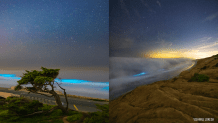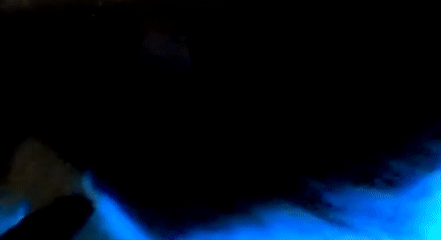Vishwas Lokesh saw the first signs of what is known as a red tide through one of the handful of live surf cameras he monitors over the weekend. With years of experience, he knows what to look for: a faint glow on the black-and-white camera indicates the unpredictable phenomenon of bioluminescence is back in San Diego.
Saturday, the ocean started glowing in San Clemente, at Crystal Cove in Los Angeles County, and very faintly in the San Diego County region. The San Diego hobbyist photographer, who daylights as a software engineer, knew it was time to grab his camera and stake out the beaches near Torrey Pines and Scripps Pier — the best locations, he says, for a sight of the electric blue waves.
In Santa Barbara as early as last weekend, the red tide, an algae bloom that discolors the water, was reported to Scripps Institution of Oceanography's SoCal Coastal Ocean Observing System (SCCOOS). It wasn't until Sunday night, though, that Lokesh found what he was looking for in San Diego County. In the days that followed, he took every opportunity to head into the darkness for the perfect shot, hopping from La Jolla to Torrey Pines and even Ocean Beach for a sighting.

Get San Diego local news, weather forecasts, sports and lifestyle stories to your inbox. Sign up for NBC San Diego newsletters.
Beautiful long-exposure photographs show near-empty shorelines with electric swells, starlit skies and the milky way — a reminder, Lokesh would tell you, of the earth's awesomeness.
"It feels like you are on another planet altogether, it’s unreal," Lokesh said, counting his blessings that he lives just 20 minutes from experiencing one of nature's most vivid shows. "It’s mesmerizing but still very calming. Just standing there makes me wonder about the amazing things that nature can provide us. It just surprises me every time. I'm just amazed by it."
SCCOOS Director Clarissa Anderson said it's hard to say what caused this month's red tide, a harmless algae bloom that makes the water appear murky in the daytime and glow blue when agitated in the darkness. But, runoff from Tropical Storm Kay could have provided additional nutrients that these particular blooms thrive on. It wouldn't be the only explanation, though. Dinoflagellate bloom is common in the late summer and early fall, she added.
San Diego has had its share of bioluminescent events in the last few years, most notably in spring 2020 when a red tide released a potent stench that hung around for months. Despite the smell, the algae was still harmless, Anderson said. We haven't seen a comparable event since, but blue waves were visible again in March 2022. Lokesh, of course, was there to capture those, too.
The San Diego photographer could be considered a "bioluminescence chaser." He got a taste of the natural wonder about four years ago and knew it was an experience he wanted to have over and over again. He connects with other Southern California die-hards on social media, like Patrick Coyne whose Instagram is flooded with sightings of bioluminescence. Working with his fellow fans, Lokesh tries to figure out where algae blooms will occur and hits San Diego locales to try to capture the glow.
"The plankton are so small, it can’t even be seen by the eye. But it's creating such a beautiful sight to see. It takes you somewhere else in your own heart and memories," Lokesh said.
He's one of the few in San Diego County, but would love to see a community of local biolum chasers grow. Instead of hoarding the moment for himself, Lokesh encourages others to experience the phenomenon while they can.
"I think taking a moment to go out and appreciate the beauty that we have in our county, being glad and going out and cherishing it will create memories for a lifetime," he said.
But the moment may not last for much longer, Scripps experts say. Lokesh said the ocean's luminosity was starting to diminish on Wednesday. Both suggest anyone who wants to catch a glimpse of the natural occurrence to head to the area north of Scripps Pier. The best chance to catch the glow is two hours after sunset, Scripps said.
If you plan to go, here's what you should know:
What is Bioluminescence?
Dinoflagellates, a type of algae that moves through the sea, create the bright blue light known as bioluminescence when they form in massive numbers. The organisms have a color that makes the ocean appear red in the daylight, hence the term red tide, and like to swim towards the surface on sunny days. But, the organisms glow when agitated as a natural defense mechanism, which becomes visible in breaking waves or when approached by other swimming organisms, especially at night.
Related Stories
Where to See a Red Tide?
Lokesh noted the best sightings are between the La Jolla Scripps Pier and Torrey Pines State Beach. But NBC 7 has seen reports as far north as Carlsbad and as far south as Ocean Beach. The phenomenon has also been reported at other Southern California beaches from San Clemente to Santa Barbara.
How Long Will the Waves Stick Around?
Red tides are unpredictable and scientists are still trying to understand when it occurs. So it’s hard to say how long this round of bioluminescence will last.
You might remember the big bioluminescent event that entertained us for about eight weeks at the beginning of the coronavirus pandemic in 2020. It’s unclear if the current event will last as long.
During the big bloom event in 2020, NBC 7 showed you a surfer who found “pure bliss” riding the glow-in-the-dark waves, and you also met Balto the husky who didn’t need a surfboard to have his fun.
Is Bioluminescence Harmful?
SCCOOS Director Clarissa Anderson, who has spent her career studying harmful algal bloom that cause devastation to marine life, says these specific red tides are not ones to worry about. While the water may appear dirty during the day, it is a common misconception, that red tide events are pollution-related or that they are a sign of unhealthy or toxic waters.
“There is an influence of nutrients coming from runoff that might help kickstart a bloom, but I don’t think we need to imagine that these red tides are a symptom of a polluted environment,” Anderson said.
The misconception could be due to the strong odor brought along by the red tide event in 2020. That, too, however unpleasant, was natural, and Anderson said stinky waves aren’t the norm.
“The situation we had in 2020 was really unique. We don’t typically see these blooms get to that point,” she said. “Normally we don’t think of these blooms as being pretty stinky. They will discolor the water red, they might cause irritation to surfers and swimmers, and we’re seeing a little bit more of that potentially, but as far as the smell goes, that was a rare event. So it will be interesting to see if that evolves again.”
The stench, according to Anderson, was caused by the blooms drawing down the oxygen levels in the water which contributed to an influx in bacteria and the decaying of organisms.
NBC 7 took note of hilarious reactions to the stench from Facebook in 2020.
How Often Does Bioluminescence Occur?
Anderson says there is no way to forecast when a bioluminescence event may occur but in Anderson’s experience, the area has seen about one bioluminescent event per year.
“In the last five years, we’ve seen one of these events almost every spring… It seems to be becoming more common in the spring. We did see some last year, too, it just wasn’t quite the duration it was in March 2020,” she said.
So, you might want to head out to a shoreline after nightfall sooner rather than later if you want to see one of Mother Nature’s coolest light shows.
Editor’s note: A paragraph referencing an bioluminescence exhibit at the Birch Aquarium has been removed as the exhibit has closed.



